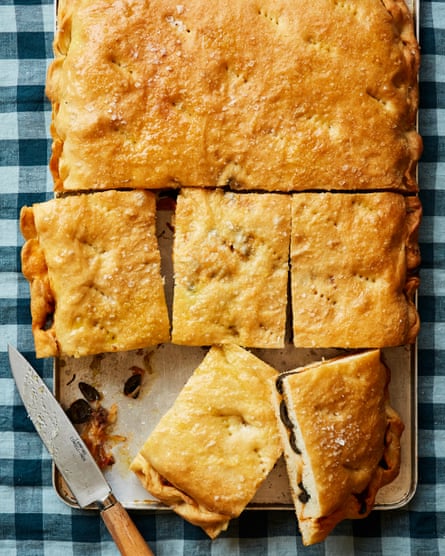Along the Adriatic coast, sardines are usually grilled over an open fire (na gradele) and served with lemon, excellent local olive oil and blitva, a side dish of young swiss chard, potato and garlic. Fresh sardines are key (they should smell of the sea) and do cook them whole (the heads add wonderful flavour and the small bones soften during cooking). On the Croatian island of Vis, two beloved pogačas (bread)– viška and komiška – tell a tale of friendly rivalry. Both are savoury bread pies (pogača being the word for bread and similar in both composition and etymology to Italian focaccia) filled with onions and salted fish (typically anchovies or sardines), a nod to the island’s ancient fishing and seafaring heritage. The key difference? Tomatoes. In Vis town (one side of the island), they’re absent; in Komiža (the other side of the island), they’re essential and cooked down into a rich sauce. The tomato version is a perfect celebration of summer.
Sardele na gradele (grilled sardines) with quick-fermented tomato sauce
The short fermentation time enhances the sauce’s depth of flavour, but not overpoweringly so – it is slightly funky, garlicky and spicy, but with a burst of freshness from the citrus and herbs. If you are adept at fermentation, feel free to leave it longer (seven to 14 days), because the flavour will get more complex with time. Once blended, the sauce will keep in the fridge for up to a week.
Prep 20 min
Ferment 72 hr+
Marinate 15 min
Cook 45 min
Serves 4-6
For the tomato sauce
300g green tomatoes, roughly chopped
1-2 long red or green chillies (30g), sliced, or more to taste
1-2 garlic cloves, peeled and sliced
¼ tsp black peppercorns
Flaky sea salt and black pepper
1 tsp caster sugar
150ml filtered water, or boiled and cooled water
3 tbsp lemon juice
1 tbsp white balsamic vinegar, or apple cider vinegar
30g fresh parsley, leaves picked and finely chopped
10g fresh oregano, leaves picked and finely chopped
For the sardines
1-1.2kg fresh whole sardines (about 20-24 fish), gutted and descaled
3 tbsp extra-virgin olive oil, plus extra for cooking
2 garlic cloves, peeled and minced
2 fresh rosemary sprigs, leaves stripped and finely chopped
2 lemons, 1 zested and juiced, 1 cut into wedges
Fresh bay leaves (optional)
Start the sauce three or four days in advance. In a clean, sterilised 500ml jar, layer the tomatoes, chillies, garlic and peppercorns. Dissolve 3g salt and half a teaspoon of sugar in the filtered water, then pour this over the tomatoes, ensuring everything is submerged (use a fermentation weight or press down with a smaller sterilised jar). Cover loosely with a lid or cheese cloth and leave at room temperature for three to four days, stirring daily. It should smell tangy, with bubbles forming by day two or three.
To cook, drain the tomatoes (reserve the brine), transfer the mix to a food processor with the remaining half-teaspoon of sugar, the lemon juice and vinegar, and blend to a chunky or smooth sauce according to your preference. Stir in the herbs, then adjust the salt or acidity to taste; if need be, add a splash of reserved brine.
Rinse the sardines under cold water, pat dry with paper towel and put in a shallow dish. In a small bowl, mix the oil, garlic, rosemary, lemon zest, a tablespoon of salt and half a teaspoon of ground black pepper, then coat the fish in this marinade and set aside for at least 15 minutes.
For outdoor cooking, prepare a barbecue and let the coals burn until they are covered with a layer of white ash. Oil the grates to prevent sticking or use a fish basket, and scatter bay leaves (if using) directly on to the hot coals. Lay the sardines perpendicular to the grates, so they won’t fall through (or in the basket) and grill for three to four minutes per side, until the skin is crisp and slightly charred and the flesh is opaque and flaky. (For indoor cooking, heat the grill to its highest setting, arrange the fish on a large lined baking sheet and grill for eight to 10 minutes.)
Serve on a platter with lemon wedges and the tomato sauce in a bowl on the side.
Komiška pogača

Good-quality tomato puree is a great shortcut for fresh tomatoes, and I love adding olives for extra flavour. For a vegan version, use capers instead of anchovies. Pogača is traditionally made with a firmer dough, but I prefer this slow-prove, no-knead method for a lighter texture. Serve warm, cut into squares, with the best olive oil you can find. A glass of plavac mali wouldn’t go amiss, either.
Prep 15 min
Prove 2 hr+
Cook 1 hr 30 min
Serves 8-12
For the dough
10g fast-acting dry yeast
1 tbsp caster sugar, or honey
525g lukewarm water
750g strong white bread flour, sifted, plus extra for dusting
Flaky sea salt and black pepper
3 tbsp extra-virgin olive oil, plus extra for brushing
For the filling
4 tbsp extra-virgin olive oil
3-4 brown onions (about 750-800g), peeled, halved and sliced into thin half-moons
2 tbsp tomato puree, ideally double concentrate
50g tin anchovy fillets in olive oil, drained and the oil reserved
100g pitted black olives (ideally in olive oil), quartered lengthways
2 sprigs fresh rosemary, leaves stripped and roughly chopped
10g fresh oregano, leaves stripped and roughly chopped
Mix the yeast, sugar and water in a small bowl and set aside for five to 10 minutes, until frothy.
Combine the flour and a tablespoon of salt in a large bowl, make a well in the middle, then add the yeast mix and a tablespoon of oil and mix to a shaggy, sticky dough. Drizzle another tablespoon of oil over the dough, cover and leave to prove in a warm place for an hour to an hour and a half, until doubled in size.
Knock back the dough: using a fork, lift and fold the edges of the dough up and over the centre, turning the bowl slightly each time. Repeat eight times, then shape back into a ball, cover and prove again for an hour to an hour and a half, until doubled in size.
Meanwhile, make the filling. Put the oil in a sauté pan on a medium-high heat. Add the onions, half a teaspoon of salt and three or four tablespoons of water, then cook, stirring occasionally, for 25-30 minutes, until soft and golden. Stir in the tomato puree and a generous grind of black pepper, cook for another two or three minutes, then take off the heat and leave to cool.
Heat the oven to 220C (200C fan)/425F/gas 7 and brush a large 24cm x 34cm baking tin with the remaining oil. Tip the dough on to a lightly floured work surface and divide it into two pieces, one slightly larger than the other. Flour your hands and roll each piece into a ball, then transfer the larger piece to the oiled tin. Using your fingertips, gently press and stretch the dough to cover the bottom of the tin. Spread the cooled onion mix over the dough, arrange the anchovies on top, and scatter on the olives, rosemary and oregano.
Flour your hands again, stretch the second piece of dough, and place it over the filling. Pinch and fold the edges to seal, then prick holes all over the top with a fork. Brush all over with the reserved anchovy oil and sprinkle over a generous pinch of flaked salt. Bake for 25-30 minutes, until deep golden brown. Remove and leave to cool for at least 15 minutes before slicing and serving.
-
Irina Janakievska’s book, The Balkan Kitchen, is published by Hardie Grant at £27. To order a copy for £24.30, visit guardianbookshop.com

 3 months ago
51
3 months ago
51

















































